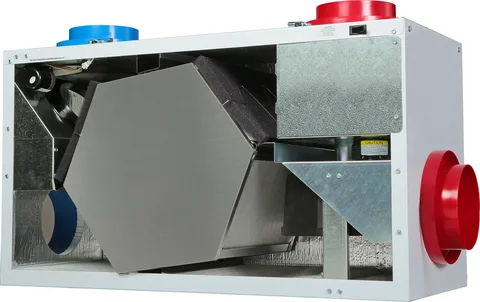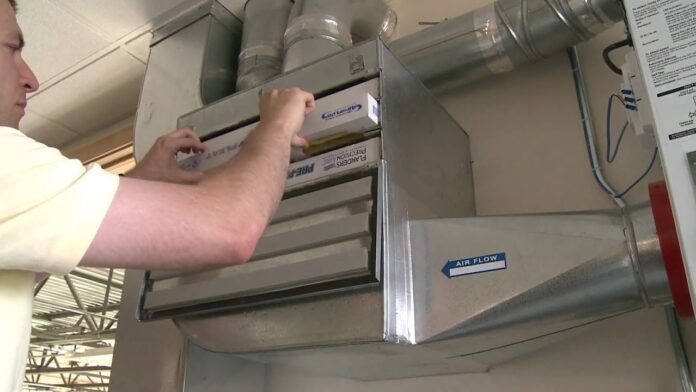Revamping your home can mean different things to different people. Some may want to add a fresh coat of paint or change their furniture whilst others may want to make their homes more energy-efficient. If you fall into the latter category, you may want to consider a heat recovery ventilation. These systems are designed to improve indoor air quality while reducing energy consumption. This blog post will explore the basics of heat recovery ventilator, their benefits, and how they differ from ERV.
Understanding the Basics of HRV
Before they delve into the benefits of heat recovery ventilation, let’s take a quick look at how they work. Essentially, a HRV is a system that replaces stale indoor air with fresh outdoor air whilst also recovering heat. It uses two ducts: one for intake and one for exhaust, which pass through a heat exchanger that transfers heat from the outgoing stale air to the incoming fresh air.
One of the benefits of hrvs is that they can help reduce your energy consumption whilst improving indoor air quality. By recovering heat from the outgoing air, hrvs can reduce the energy needed to heat or cool your home, which can help you reduce your carbon footprint.
But how do you know if an HRV is right for your home? Factors such as the size of your home, the number of occupants, and your budget should all be considered. And, of course, it’s important to properly size and install the system and regularly clean or replace the air filters to ensure efficient performance.
Benefits of ERV
If you live in a humid climate, an ERV may be better than a HRV. Ervs recover heat and moisture, making them ideal for maintaining a comfortable indoor humidity level. In addition to reducing energy consumption, ervs improve indoor air quality by providing a constant supply of fresh outdoor air while removing stale indoor air.
Reducing energy consumption
Ervs can help reduce energy consumption by recovering heat and moisture from outgoing air and transferring it to incoming air. This means less energy is needed to heat or cool the air, which can lead to lower energy bills and a reduced carbon footprint.
Improving indoor air quality
Ervs can help improve indoor air quality by constantly supplying fresh outdoor air while removing stale indoor air. This can reduce the risk of respiratory problems caused by poor indoor air quality.
Maintaining a Comfortable Indoor Humidity Level
Ervs are designed to maintain a comfortable indoor humidity level by transferring moisture from outgoing air to incoming air. This can be particularly beneficial in humid climates where excess moisture can cause problems such as mound growth and increased humidity levels.
 What Is An Energy Recovery Ventilator?
What Is An Energy Recovery Ventilator?
Energy Recovery Ventilator (erv) is similar to hrvs but differ in their ability to handle moisture. In humid climates, ervs are a great option as they not only recover heat but also moisture, which helps to maintain a comfortable indoor humidity level. This is important as excess moisture can cause problems such as mould growth and increased humidity levels.
Ervs use a heat exchanger that transfers heat and moisture from the outgoing air to the incoming air. This means that the incoming air is pre-cooled and dehumidified in the summer, while in the winter, it’s pre-warmed and humidified.
When choosing between hrvs and ervs, it’s important to consider your climate and ventilation needs. If you live in a dry climate, an HRV may be sufficient. However, an ERV may be a better option if you live in a humid climate. It’s also important to properly size and install the system and regularly clean or replace the air filters to ensure efficient performance.
Choosing Between Heat Recovery and ERV
Now that we’ve explored the basics of hrvs and ERV, it’s time to choose which is right for your home. Firstly, consider your climate. If you live in a dry climate, an HRV may be sufficient. However, an ERV may be a better option if you live in a humid climate as it helps maintain a comfortable indoor humidity level.
Next, consider your ventilation needs. Hrvs are designed to recover heat from outgoing air, while ervs recover heat and moisture. If you’re looking to improve your home’s energy efficiency and indoor air quality, both options are great choices. However, if you live in a humid climate, you may want to opt for an ERV.
Finally, consider your budget and the size of your home. Hrvs and ervs come in various sizes and price ranges, so choosing one that suits your needs is important. It’s also important to properly size and install the system and regularly clean or replace the air filters to ensure efficient performance.
Efficient Performance of Heat Recovery Ventilation
To ensure your heat recovery ventilation is working efficiently, you should perform a few maintenance tasks. Firstly, it’s important to regularly clean or replace the air filters. This is because the filters can become clogged with dirt and debris, reducing the system’s efficiency and indoor air quality.
Another important aspect of maintaining your HRV system is checking the ductwork for leaks or damage. If there are leaks in the ductwork, it can cause the system to work harder than necessary, leading to reduced efficiency and increased energy consumption. It’s also important to check the fan blades for any damage or debris, as this can impact the system’s efficiency and air flow.
Finally, having your HRV system serviced annually by a qualified technician is a good idea. They can check the system’s components, clean the unit, and ensure it works efficiently. By regularly maintaining your HRV system, you can improve its performance and lifespan, reducing your energy consumption and improving your indoor air quality.
Embracing Sustainability with Heat Recovery Ventilation Systems
Looking for sustainable options for your home? Heat Recovery Ventilation System (hrvs) could be just what you need. Hrvs help reduce energy consumption while improving indoor air quality, making them an eco-friendly choice. By recovering heat from outgoing air, hrvs reduce the energy needed to heat or cool your home, which means a reduced carbon footprint.
If you want to embrace sustainability in your home, an HRV could be a great place to start. They’re easy to maintain and can be tailored to your specific needs, making them versatile. Plus, with the energy cost rising, an HRV could help you save money on your energy bills while also doing your part for the environment.
Maximising Indoor Air Quality with HRV Systems
Indoor air quality is crucial for maintaining a healthy home environment. With a heat recovery ventilation (HRV) system, you can improve your indoor air quality by providing a constant supply of fresh outdoor air while removing stale indoor air. But to truly maximise indoor air quality, there are a few things to remember.
Firstly, regularly clean or replace your air filters. Over time, the filters can become clogged with dirt and debris, reducing your HRV system’s efficiency. Generally, it’s recommended that you clean or replace your filters every three to six months, but this can vary depending on your home’s ventilation needs.
Secondly, properly size and install your HRV system. If your HRV system is too small for your home, it may not be able to effectively remove stale air and replace it with fresh outdoor air. On the other hand, if your HRV system is too large, it may use more energy than necessary to maintain indoor air quality.
Maintenance Tips for Your Ventilation System
To keep your ventilation system running smoothly, regular maintenance is essential. Here are some tips to help you maintain your system:
Clean or replace air filters regularly
Clogged filters can reduce the efficiency of your ventilation system, which can impact your indoor air quality and energy consumption. You should clean or replace the filters every three to six months, but this can vary depending on your home’s ventilation needs.
Check for leaks
Leaks in your ventilation system can cause it to work harder than necessary, leading to reduced efficiency and increased energy consumption. Check your ductwork for leaks and have them repaired as soon as possible.
Check the fan blades
Debris or damage to the fan blades can impact the efficiency of your ventilation system and air flow. Regularly check the fan blades and clean or repair them as needed.
Schedule annual maintenance
It’s a good idea to have a qualified technician service your ventilation system annually. They can check the system’s components, clean the unit, and ensure it works efficiently.
Ventilation Maintenance Tips For MVHR Systems
Suppose you have a Mechanical Ventilation with Heat Recovery (MVHR) system in your home. In that case, you’re already on the right track to improving indoor air quality and reducing energy consumption. However, regular maintenance is essential to keep your MVHR system running smoothly.
One important step in maintaining your MVHR system is regularly cleaning or replacing the air filters. Clogged filters can reduce the efficiency of your ventilation system, which can impact your indoor air quality and energy consumption. Depending on your home’s ventilation needs, you should clean or replace the filters every three to six months.
Another key maintenance tip is to check your ductwork for leaks and have them repaired as soon as possible. Leaks in your ductwork can cause your MVHR system to work harder than necessary, reducing efficiency and increasing energy consumption.
FAQs
1. What’s The Difference Between HRV And ERV?
Hrvs and ervs work similarly, exchanging stale indoor air with fresh outdoor air. However, ervs exchange moisture, maintaining indoor humidity levels, making them ideal for humid climates.
2. How Often Should I Clean or Replace the Filters in My Ventilation System?
It’s generally advised to clean or replace filters every three to six months, but this may vary depending on your home’s ventilation needs and the manufacturer’s recommendations.
3. Can HRV/ERV Systems Reduce My Energy Bills?
By recovering heat from the outgoing air and transferring it to the incoming air, these systems reduce the energy needed to heat or cool your home, potentially lowering your energy bills.
4. Can An HRV/ERV Improve My Home’s Indoor Air Quality?
Absolutely. Both systems constantly supply fresh outdoor air whilst removing stale indoor air, significantly improving indoor air quality.
5. Is It Better To Have My Ventilation System Serviced Professionally?
While some maintenance tasks can be done yourself, having your system serviced annually by a qualified technician is a good idea to ensure it works efficiently.
Conclusion
In a world where energy conservation and indoor air quality are becoming increasingly importance, hrs. and ERVs offer a solution that serves both these purposes. From improving indoor air quality to reducing your carbon footprint and potentially cutting down on energy bills, the benefits of these systems are clear. Choosing between an HRV and ERV depends on your specific climate and ventilation needs. Maintaining the system well is vital for it to function efficiently and last longer. By opting for an HRV or ERV, you’re taking a significant step towards a more sustainable lifestyle. So, consider including a heat recovery ventilation as you plan your next home renovation. Your health, your wallet, and the planet will thank you!
| Other Good Articles to Read |
| Niche Blogs Connect |
| Blogs 97 |
| Blog Stitution |
| Blogs Unplugged |
| Blogs Cotch Rouge |
| Blog Signatr |
| Blog Sintonias |
| Blog Zilla |
| Consumer Forums |
| Finance Forums |
| G Blogs |
| Too Blog |
| Related Business Listings |
| Contact Directory |
| Local Business Profiles |

